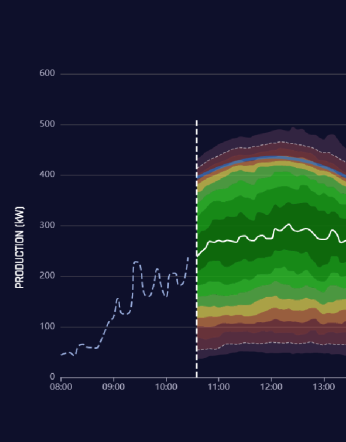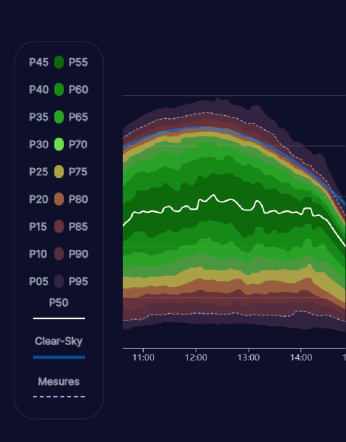NEXT - Algorithm technology
A Machine Learning Algorithm
K-NN Method
NEXT uses an ensemble statistical learning methodology developed in-house.
The NEXT algorithm is based on an ensemble statistical learning methodology of the k-nearest neighbors (kNN) type.
The NEXT algorithm combines several complementary input data sources with divergent spatial and temporal scales (NWP, satellite, in-situ measurements). It searches for similar patterns to the current meteorological situation in the data history, using an advanced method of estimating similarity between two meteorological situations developed in-house.
The algorithm aims to push back the limits of the state of the art, taking not only raw data from different sources, but also data transformed using standard models generally available on the market.
Thus, NEXT natively takes a combination of several weather models as input, as well as irradiance map forecasts from satellite imagery combined with robust and proven forecasting techniques such as Cloud Motion Vector (CMV).

Direct PV production forecasts
NEXT is able to provide direct PV production forecasts using real time data for a better representation of the photovoltaic plant's behavior.
There are two methods for anticipating production:
- The first, used by NEXT, involves an irradiance forecast followed by a power or energy conversion calculation, enabling detailed modeling of all irradiance components.
- The second involves directly forecasting power or energy, if measurements are available, offering a better representation of the photovoltaic plant's behavior.
NEXT algorithm seamlessly assigns relevant weights to its sources, across all time horizons, for its forecasts.
NEXT also integrates real-time site measurements. These measurements are used by the algorithm to constantly updated its forecasts based on the latest observations. The algorithm is continuously calibrated using real data collected by on-site sensors, enabling direct PV power forecast.
PROBABILISTIC

NEXT generates probabilistic ensemble forecasts from P5 to P95.
The technology used by NEXT works by searching for similarity in the history of the combination of input data. It allows generating probabilistic ensemble forecasts by nature calibrated on the target value to predict.
Indeed, this method identifies a set of moments in history for which the predictors indicated a similar meteorological situation. Consequently, all the uncertainty related to the variability of the observations that can be obtained for the same situation is contained in this set of observations. Thus, it does not simply model the uncertainty related to the error on the parameters of the model as is classically done by bootstrap or ensemble NWP methods but rather the total uncertainty of the model, including that related to model bias.
The algorithm is set to natively provide probabilistic quantiles ranging from P5 to P95 in increments of 5%, very well calibrated on the real quantiles observed in the measurements (or satellite data in the case of the mode without in-situ data).
By using NEXT, an asset manager is guaranteed to have access to reliable prediction quantiles representing the true variability and uncertainty of on-site data, allowing for realistic production scenarios to be constructed.


 en
en 
 fr
fr es
es de
de